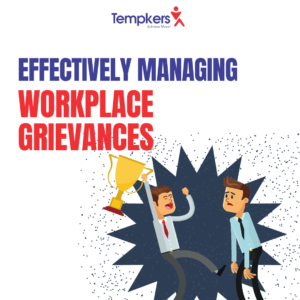
Making Critical Manpower Decisions
One critical decision every HR professional is faced with is ensuring that the manpower needs of a company is met. This means that we have

Employee effectiveness relates to the ability to achieve set goals, which should be directly proportional to that of an organization’s. An organization’s goals are focused on enhanced productivity, establishing a healthy work environment and better revenue and profits.
but please note Employee effectiveness does not automatically translate into employee efficiency. In order to assess an employees’ effectiveness, it is essential that they know what is expected of them.
In a workplace, performing holds more significance than just going about completing tasks; here’s where efficiency comes into the picture as a vital measure of an employee’s effectiveness. An organisation is effective if it achieves its goals.
This approach can only be used in organisations with clearly defined, time-sensitive, measurable and operational goals. In the literature relating to organisational effectiveness, it has been proposed that only a few organisations meet these criteria.
Even so, it is difficult to determine an organisation’s effectiveness without relating it to the organisation’s goals, even if these are not clearly defined. Broadly speaking, the goal attainment approach reflects the views about effectiveness of senior management and shareholders.
Here are a few approaches you can follow in other to be an effective employee:
Prioritizing your goals allows you to organize your objectives and better allocate your time and effort. Try these tactics to accomplish your goals. Goal prioritization is the process of identifying your objectives and organizing them based on their urgency, value, and importance.
This process also requires you to appropriately allocate your resources, time, and effort where they’re needed the most.
It’s basically a fancy term for what you might already be doing: Determining what to focus on first before moving on to other tasks. One of the few ways in which we can prioritize our goal is to first identify them we are often tempted to create a long list of goals that you’re motivated to accomplish, but you’ll need to narrow your focus to be as effective as possible in your work.
It is also important that we measure our progress which would in turn lead to the realization. How to prioritize your goals at work
Let’s say you’ve already set your goals and determined everything you’ll need to complete them. All the parts are in place, so isn’t ranking your goals just an extra step? Not at all! If anything, goal prioritization is a key piece of the productivity puzzle.
Below are a few steps that seamlessly integrate goal prioritization into what you’re already doing. This way, identifying important tasks and setting daily priorities can take up barely any time on your schedule.
To give yourself a clear picture of what you want to accomplish, try identifying some goals you’d like your company or team to achieve. These objectives can be a combination of long-term goals that you work on for the next year (or few years).
They can also include short-term goals that span just a few weeks or months. Either way, write them down! Having them on paper makes them way easier to reference as you create action plans and present them to your teams.
Once you’ve identified your goals, you should make a list of the highly specific tasks comprising them. This way, you’ll have a good idea of what work, and just how much work, you’ll need to put into accomplishing your objectives.
You’ll also get an overview of how long each task might take. You can then prioritize tasks based on when (or, if recurring, how often) they must be completed.
4. Measure your progress
As you work toward your goals, you should always track progress. This way, you can clearly understand where you are in the process now – and look back on everything later to better plan future work. If you’re clearly behind on your current goals, you can drop the goals or tasks that fall lower on your list.
Don’t feel guilty you’re putting your best work into what matters the most.
Defining and prioritizing your goals is an important step, but it’s only half the battle. Once you get to work, you’ll need to remain focused, diligent, and determined so you don’t accidentally drop the ball.
Creating a schedule and detailed to-do lists can help you stay accountable here. You can also ask your leadership team to check in with you periodically to keep you on track.
Sure, you might not think twice about checking your phone during work, but even tiny glances take time away from your tasks. Even meetings can be distractions, so cancel any meetings that don’t serve a clear, strong purpose.
If you regularly hear “this meeting could’ve been an email,” you’re likely having too many meetings. Drop some in favor of directly working on your goals.
For many of us, “employee feedback” sparks memories of uncomfortable annual conversations with unapproachable managers. In today’s world, however, employee feedback has evolved into ongoing listening strategies that build trust between managers and employees.
Regular employee feedback results in significantly higher engagement. The value of positive employee feedback is obvious.
It reinforces the right behaviors, and it is directly linked to increased employee effectiveness and productivity. Negative employee feedback is equally important.
When provided constructively, it reduces negative behaviors and helps employees understand their strengths and weaknesses. The right feedback, given at a critical juncture, can have a significant impact on behaviors, skills, and ultimately careers.
Feedback that is constructive is vital to employees’ ongoing development. Feedback clarifies expectations, helps people learn from their mistakes and builds confidence. Constructive feedback is one of the best things managers can provide to their employees.
Performance measurement is used to motivate employee to make decision beneficial to both employer and employee this is done base on controllable factors which are the component of the organization for which an employee is made to align objective of the management and the goals of the organization.
Here are a few ways to measure and evaluate employee performance data: Graphic rating scales. A typical graphic scale uses sequential numbers, such as 1 to 5, or 1 to 10, to rate an employee’s relative performance in specific areas
Flexible schedules benefit both the employer and employee in numerous ways. And though it may represent a massive shift in how you’ve done things before, embracing flexible scheduling now will help you succeed in the future.
There are some benefits of effective employee scheduling
Things that may seem like an inefficient use of time today can actually be to your advantage in the long run. So before you veto an apparent poor use of time, ask yourself how it could benefit your business.
Investing in HR software now can save your business – and your employees – countless hours in the long run. From automated integration to automated payroll, adopting HR technology will improve efficiency, reduce frustration and help your business grow.
By using a number of our efficiency tips, you can be sure you don’t fall behind and put that extra hour to useful and productive use.
Employee effectiveness can be sustained and analyzed by productivity monitoring systems. These systems ensure that operations are managed systematically. Encouraging accountability, keeping track of the attendance and movement data, and simplified communication between manager and employee are some of the benefits of this solution.

One critical decision every HR professional is faced with is ensuring that the manpower needs of a company is met. This means that we have

What is Hazard pay? This is a payment that is made in addition to a worker’s regular salary as a bonus for accepting a job

Have you ever driven your car on 2,3 or 4 flat tires for 10 kilometres ? How did it feel? What was the impact of

Your ability to effectively manage Grievance, can make you a star In a workplace grievances must happen, your ability to effectively manage them makes you

Every CEO desires to have a dream team. People who would come together and give their best to running and growing the business. Most times

In this HR series, we will be discussing FORECASTING How many eyes do you have? Many years ago as children, we were playing hide and
WhatsApp us